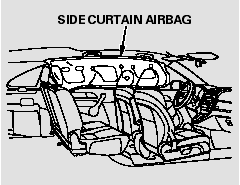Honda CR-V: How Your Side Curtain Airbags Work

In a Side Impact
In a moderate to severe side impact,
sensors will detect rapid acceleration
and signal the control unit to
instantly inflate the side curtain
airbag.
If the impact is on the passenger’s
side, the passenger’s side curtain
airbag will inflate even if there are no
occupants on that side of the vehicle.
In a Rollover
If the rollover sensor detects your
vehicle is about to roll over, it signals
the control unit, which immediately
deploys both side curtain airbags and
activates both front seat belt
tensioners.
The airbag on the passenger’s side
will deploy, and the seat belt
tensioner will activate, even if there
are no passengers on that side of the
vehicle.
To get the best protection from the
side curtain airbags, occupants
should wear their seat belts and sit
upright and well back in their seats.
READ NEXT:
The SRS indicator alerts you to a
potential problem with your airbags
or seat belt tensioners.
When you turn the ignition switch to
the ON (II) position, this indicator
comes on briefly t
This indicator alerts you that the
passenger’s side airbag has been
automatically shut off. It does
mean there is a problem with your
side airbags.
not
When you turn the ignition switc
This indicator alerts you that the
passenger’s front airbag has been
shut off because weight sensors
detect about 65 lbs (29 kg) or less
(the weight of an infant or small
child) on the
SEE MORE:
Component Location Index-Front Door
DOOR CENTER OUTER TRIM
DOOR LINING BRACKETS
DOOR OUTER MOLDING
Replacement
DOOR GLASS OUTER
WEATHERSTRIP
Replacement
HINGE
DOOR CHECKER
DOOR
Position Adjustment
SPEAKER
DOOR WEATHERSTRIP
Replacement
PLASTIC COVER
DO
Never let passengers ride in the
cargo area or on top of a foldeddown back seat. If they do, they
could be very seriously injured in a
crash.
Passengers should not stand up or
change seats while the vehicle is
moving. A passenger who is not
wearing a seat belt during a crash
or emerge
© 2016-2026 Copyright www.hcrv.net



